Laplace demon
description: a hypothetical, all-knowing entity that can predict the future based on complete knowledge of the present
17 results
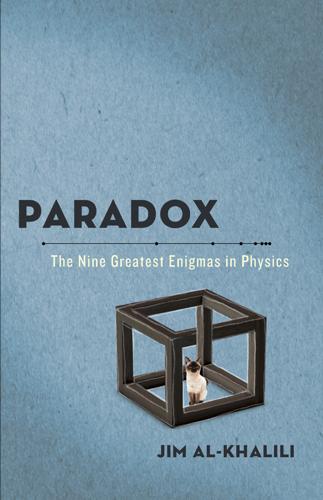
Paradox: The Nine Greatest Enigmas in Physics
by
Jim Al-Khalili
Published 22 Oct 2012
And how then do we resolve the Paradox of Laplace’s Demon? We can briefly compare this situation with the time-travel paradoxes of the last chapter. In that case, our past was fixed and known to us, but we had to travel to it in order to change it and force paradox. Here, Laplace’s demon knows the future, but doesn’t require time travel; it just waits for the future to come to it, and while waiting it can meddle with the present to force a different future to evolve. One not very scientific way of ruling out time-travel paradoxes is to insist that time travel to the past is simply impossible. But in the case of Laplace’s demon, no time travel is necessary; the demon cannot escape the future, which is heading its way even if it does nothing, so it looks like we need another explanation to resolve the paradox.
…
Q173.A395 2012 500—dc23 2012005011 eISBN: 978-0-307-98680-1 Illustrations: Patrick Mulrey Cover design: Kyle Kolker Cover photography: istockphoto v3.1 To Julie, David, and Kate Contents Cover Title Page Copyright Dedication Preface 1 The Game Show Paradox 2 Achilles and the Tortoise 3 Olbers’ Paradox 4 Maxwell’s Demon 5 The Pole in the Barn Paradox 6 The Paradox of the Twins 7 The Grandfather Paradox 8 The Paradox of Laplace’s Demon 9 The Paradox of Schrödinger’s Cat 10 Fermi’s Paradox 11 Remaining Questions Acknowledgments About the Author Preface Paradoxes come in all shapes and sizes. Some are straightforward paradoxes of logic with little potential for investigation, while others sit atop icebergs of entire scientific disciplines.
…
Or there may be a more mundane reason: expecting to see time travelers among us presupposes that they would, in fact, want to visit this century. Maybe for them there will be much nicer and safer periods to visit. Or it just might be that time travelers from the future are indeed among us, but choose to keep a low profile. 8 THE PARADOX OF LAPLACE’S DEMON Can the flapping of a butterfly’s wings rescue us from a predictable future? “Prediction is very difficult, especially about the future.” So said the Danish quantum physicist Niels Bohr. The quote might sound trite and frivolous, but hidden behind it, as was so often the case with the utterances of Bohr, are profound ideas about the nature of fate, free will, and our ability to determine how the future will unfold.
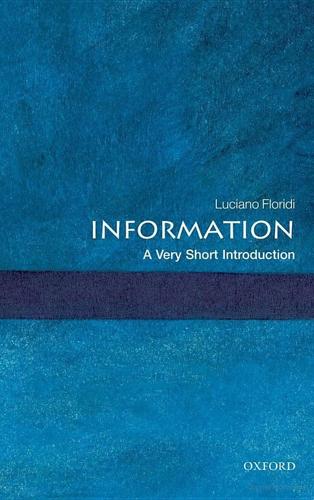
Information: A Very Short Introduction
by
Luciano Floridi
Published 25 Feb 2010
Moreover, if the world were a computer, this would imply the total predictability of its developments and the resuscitation of another demon, that of Laplace. Pierre-Simon Laplace (1749-1827), one of the founding fathers of mathematical astronomy and statistics, suggested that if a hypothetical being (known as Laplace's demon) could have all the necessary information about the precise location and momentum of every atom in the universe, he could then use Newton's laws to calculate the entire history of the universe. This extreme form of determinism was still popular in the 19th century, but in the 20th century was undermined by the ostensibly probabilistic nature of quantum phenomena.
…
Nowadays, the most accepted view in physics is that particles behave indeterministically and follow the uncertainty principle. To the best of our knowledge - that is, at least according to the Copenhagen interpretation of quantum mechanics, which is the most widely accepted among physicists - computational determinism is not an option, Laplace's demon is a ghost, and digital physics shares its fate. A digital reinterpretation of contemporary physics may still be possible in theory, but a metaphysics based on informationtheoretic grounds seems to offer a more promising approach. Following Wiener and Wheeler, one might interpret reality as constituted by information, that is, by mind-independent, structural entities that are cohering clusters of data, understood as concrete, relational points of lack of uniformity.
…
The presence of a sequence of moves is insufficient without some access to them, for in that case the game is effectively simultaneous and the difference in time has no strategic import. If all players have information about all the previous moves or states of all the other players then the sequential game is one of perfect information. Maxwell's demon and Laplace's demon (Chapter 6) may be described as complete- and perfect-information single-player games. If only some players have perfect information, then we shall see below that the sequential game is one of imperfect information. Examples in this case include Scrabble, a game in which each player is not informed about what tiles are held by another player, and poker, for the same reason.

From eternity to here: the quest for the ultimate theory of time
by
Sean M. Carroll
Published 15 Jan 2010
His later biographers found this a bit dry, so they attached a label to this hypothetical intellect: Laplace’s Demon. Laplace never called it a demon, of course; presumably he had no need to hypothesize demons any more than gods. But the idea captures some of the menace lurking within the pristine mathematics of Newtonian physics. The future is not something that has yet to be determined; our fate is encoded in the details of the current universe. Every moment of the past and future is fixed by the present. It’s just that we don’t have the resources to perform the calculation.105 There is a deep-seated impulse within all of us to resist the implications of Laplace’s Demon. We don’t want to believe that the future is determined, even if someone out there did have access to the complete state of the universe.
…
If it’s your boyfriend or girlfriend you are interested in, all you need to do is precisely specify the position and momentum of every atom in his or her body. The rules of classical mechanics give unambiguous predictions for how the system will involve, using only the information of its current state. Once you specify that list, Laplace’s Demon takes over, and the rest of history is determined. You are not as smart as Laplace’s Demon, nor do you have access to the same amount of information, so boyfriends and girlfriends are going to remain mysterious. Besides, they are open systems, so you would have to know about the rest of the world as well. It will often be convenient to think about “every possible state the system could conceivably be in.”
…
Yes, I think you’re the first person to think of this.106 We won’t be exploring whether sexual attraction helps us wriggle free of the iron grip of determinism. Our concern is with why the past seems so demonstrably different from the future. But that wouldn’t be nearly the puzzle it appears to be if it weren’t for the fact that the underlying laws of physics seem perfectly reversible; as far as Laplace’s Demon is concerned, there’s no difference between reconstructing the past and predicting the future. Reversing time turns out to be a surprisingly subtle concept for something that would appear at first glance to be relatively straightforward. (Just run the movie backward, right?) Blithely reversing the direction of time is not a symmetry of the laws of nature—we have to dress up what we really mean by “reversing time” in order to correctly pinpoint the underlying symmetry.
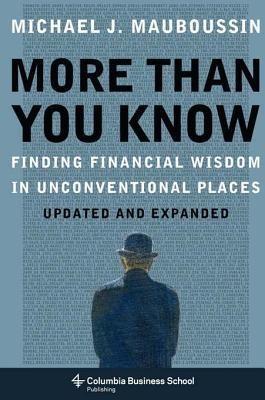
More Than You Know: Finding Financial Wisdom in Unconventional Places (Updated and Expanded)
by
Michael J. Mauboussin
Published 1 Jan 2006
Swarm Smarts Chapter 30 - Vox Populi The Accuracy of Crowds Needle in a Haystack Weighing the Ox with the Vox Estimating Printers with Populi And Now, For the Real World Chapter 31 - A Tail of Two Worlds Experience Versus Exposure Tell Tail What Fat Tails Mean for Investors Chapter 32 - Integrating the Outliers Bernoulli’s Challenge What’s Normal? St. Petersburg and Growth Stock Investing Integrating the Outliers Chapter 33 - The Janitor’s Dream Beyond Newton Sorting Systems The Stock Market as a Complex Adaptive System Using What You’ve Got Chapter 34 - Chasing Laplace’s Demon Evolution Made Me Do It Laplace’s Demon Interpreting the Market Investor Risks Chapter 35 - More Power to You Zipf It The More Things Change . . . Catch the Power Chapter 36 - The Pyramid of Numbers Firm Size, Growth Rates, and Valuation Why Big Fierce Animals Are Rare Find Your Niche Dear CEO: We’ve Made It to the Fortune 50!
…
Investors and corporate managers trying to understand the market must recognize that it’s a complex adaptive system. The market’s action reflects the interaction of many agents, each with varying knowledge, resources, and motivation. So a disproportionate focus on individual opinions can be hazardous to wealth creation. 34 Chasing Laplace’s Demon The Role of Cause and Effect in Markets [Our ancestors] must have felt uncomfortable about their inability to control or understand such [causeless] events, as indeed many do today. As a consequence, they began to construct, as it were, false knowledge. I argue that the primary aim of human judgment is not accuracy but the avoidance of paralyzing uncertainty.
…
An appreciation of our need for explanation can be an inoculation against making mistakes. Investors who insist on understanding the causes for the market’s moves risk focusing on faulty causality or inappropriately anchoring on false explanations. Many of the big moves in the market are not easy to explain. Laplace’s Demon Two hundred years ago, determinism ruled in science. Inspired by Newton, scientists largely embraced the notion of a clockwork universe. The French mathematician Pierre Simon Laplace epitomized this thinking with a famous passage from A Philosophical Essay on Probabilities:An intellect which at any given moment knew all of the forces that animate Nature and the mutual positions of the beings that comprise it, if this intellect were vast enough to submit its data to analysis, could condense into a single formula the movement of the greatest bodies of the universe and that of the lightest atom: for such an intellect nothing could be uncertain; and the future just like the past would be present before its eyes.
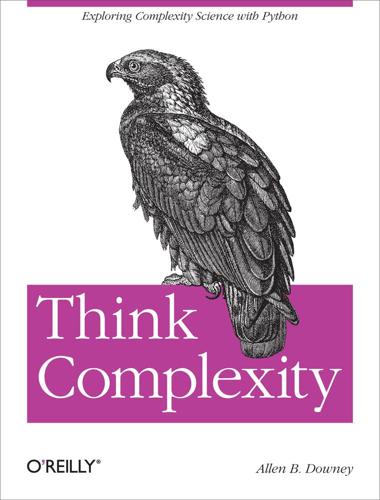
Think Complexity
by
Allen B. Downey
Published 23 Feb 2012
An intellect which at a certain moment would know all forces that set nature in motion, and all positions of all items of which nature is composed, if this intellect were also vast enough to submit these data to analysis, it would embrace in a single formula the movements of the greatest bodies of the universe and those of the tiniest atom; for such an intellect nothing would be uncertain and the future just like the past would be present before its eyes. This intellect came to be called “Laplace’s demon” (see http://en.wikipedia.org/wiki/Laplace’s_demon). The word “demon” in this context has the sense of “spirit,” with no implication of evil. Discoveries in the 19th and 20th centuries gradually dismantled this hope. The thermodynamic concept of entropy, radioactive decay, and quantum mechanics posed successive challenges to strong forms of determinism.
…
harmonics, Spectral Density hash function, Hashtables HashMap, Hashtables hashtables, Hashtables Hertz, Spectral Density Hist, Zipf’s Law histograms, Cumulative Distributions hoisting, Spectral Density holism, A New Kind of Model holistic model, Reductionism and Holism, Reductionism and Holism Homo economicus, The Axes of Scientific Models homogeneous, The Axes of Scientific Models hop, Stanley Milgram hurricane, Realism, Instrumentalism I id, Instrumentalism immutable objects, Representing Graphs implementing cellular automata, Implementing CAs implementing Game of Life, Implementing Life in operator, Analysis of Search Algorithms incompleteness, A New Kind of Thinking Incompleteness Theorem, A New Kind of Thinking indeterminism, A New Kind of Thinking indexing, Analysis of Basic Python Operations, Fast Fourier Transform infinite loop, Generators infinite sequence, Iterators inheritance, Representing Graphs, Representing Graphs __init__, Representing Graphs instantiate, CADrawer instrumentalism, A New Kind of Model, Instrumentalism interactions, minimizing, A New Kind of Engineering interface, CADrawer, CADrawer implementing, CADrawer specifying, CADrawer IPython, Summing Lists isolation of components, A New Kind of Engineering __iter__, Iterators iterator, Iterators iteritems, List Comprehensions itertools, Iterators J join, Analysis of Basic Python Operations K Kansas, Stanley Milgram kernel, Implementing Life KeyError, Hashtables Kosko, Bart, A New Kind of Thinking Kuhn, Thomas, Paradigm Shift?, A New Kind of Thinking, A New Kind of Thinking, Explanatory Models L label attribute, Representing Graphs labelling nodes, Dijkstra lambda calculus, Universality Langton, Chris, Turmites Langton’s ant, Turmites Laplace, Pierre-Simon, Determinism Laplace’s demon, Determinism leading coefficient, Order of Growth leading term, Order of Growth __len__, Hashtables Life, Implementing Life LifeViewer, Implementing Life line, Fractals linear algorithm, Summing Lists linear congruential generator, Randomness linear growth, Order of Growth linear search, Analysis of Search Algorithms linear system, The Axes of Scientific Models LinearMap, Hashtables list comprehension, List Comprehensions list methods, Analysis of Basic Python Operations list of tuples, List Comprehensions The Little Book of Semaphores, Dijkstra local connection, Stanley Milgram local information, Boids log-log plot, Zipf’s Law, Pareto Distributions, Zipf, Pareto, and Power Laws, Fractals, Pink Noise log-log scale, Summing Lists logarithm, Zipf’s Law logarithmic growth, Order of Growth logic, A New Kind of Thinking long tail, Pareto Distributions, Sand Piles long-tailed distribution, Reductionism and Holism, SOC, Causation, and Prediction M machine model, Analysis of Algorithms Mandelbrot, Benoit, Reductionism and Holism many-valued logic, A New Kind of Thinking Massachusetts, Stanley Milgram mathematical proofs, A New Kind of Science, Paradigm Shift?
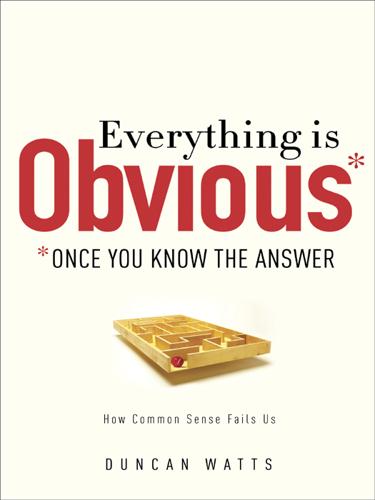
Everything Is Obvious: *Once You Know the Answer
by
Duncan J. Watts
Published 28 Mar 2011
Likewise, predictions that the United States will not go to war with Canada in the next decade or that the sun will continue to rise in the east are also likely to be accurate, but impress no one. The real problem of prediction, in other words, is not that we are universally good or bad at it, but rather that we are bad at distinguishing predictions that we can make reliably from those that we can’t. LAPLACE’S DEMON In a way this problem goes all the way back to Newton. Starting from his three laws of motion, along with his universal law of gravitation, Newton was able to derive not only Kepler’s laws of planetary motion but also the timing of the tides, the trajectories of projectiles, and a truly astonishing array of other natural phenomena.
…
Laplace envisioned an “intellect” that knew all the forces that “set nature in motion, and all positions of all items of which nature is composed.” Laplace went on, “for such an intellect nothing would be uncertain and the future just like the past would be present before its eyes.”7 The “intellect” of Laplace’s imagination eventually received a name—“Laplace’s demon”—and it has been lurking around the edges of mankind’s view of the future ever since. For philosophers, the demon was controversial because in reducing the prediction of the future to a mechanical exercise, it seemed to rob humanity of free will. As it turned out, though, they needn’t have worried too much.
…
Put another way, there is a difference between being uncertain about the future and the future itself being uncertain. The former is really just a lack of information—something we don’t know—whereas the latter implies that the information is, in principle, unknowable. The former is the orderly universe of Laplace’s demon, where if we just try hard enough, if we’re just smart enough, we can predict the future. The latter is an essentially random world, where the best we can ever hope for is to express our predictions of various outcomes as probabilities. Past Versus Future Stock Price PREDICTING WHAT TO PREDICT The distinction between predicting outcomes and predicting probabilities of outcomes is a fundamental one that should change our view about what kinds of predictions we can make.
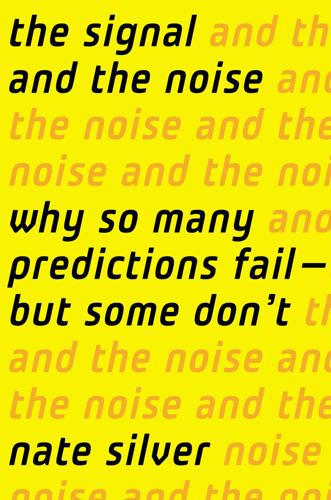
The Signal and the Noise: Why So Many Predictions Fail-But Some Don't
by
Nate Silver
Published 31 Aug 2012
The idea of scientific, technological, and economic progress—which by no means could be taken for granted in the centuries before then—began to emerge, along with the notion that mankind might learn to control its own fate. Predestination was subsumed by a new idea, that of scientific determinism. The idea takes on various forms, but no one took it further than Pierre-Simon Laplace, a French astronomer and mathematician. In 1814, Laplace made the following postulate, which later came to be known as Laplace’s Demon: We may regard the present state of the universe as the effect of its past and the cause of its future. An intellect which at a certain moment would know all forces that set nature in motion, and all positions of all items of which nature is composed, if this intellect were also vast enough to submit these data to analysis, it would embrace in a single formula the movements of the greatest bodies of the universe and those of the tiniest atom; for such an intellect nothing would be uncertain and the future just like the past would be present before its eyes.13 Given perfect knowledge of present conditions (“all positions of all items of which nature is composed”), and perfect knowledge of the laws that govern the universe (“all forces that set nature in motion”), we ought to be able to make perfect predictions (“the future just like the past would be present”).
…
The movement of every particle in the universe should be as predictable as that of the balls on a billiard table. Human beings might not be up to the task, Laplace conceded. But if we were smart enough (and if we had fast enough computers) we could predict the weather and everything else—and we would find that nature itself is perfect. Laplace’s Demon has been controversial for all its two-hundred-year existence. At loggerheads with the determinists are the probabilists, who believe that the conditions of the universe are knowable only with some degree of uncertainty.* Probabilism was, at first, mostly an epistemological paradigm: it avowed that there were limits on man’s ability to come to grips with the universe.
…
It happens at a molecular (rather than an atomic) level, and molecules are much too large to be discernibly impacted by quantum physics. Moreover, we understand the chemistry and Newtonian physics that govern the weather fairly well, and we have for a long time. So what about a revised version of Laplace’s Demon? If we knew the position of every molecule in the earth’s atmosphere—a much humbler request than deigning to know the position of every atomic particle in the universe—could we make perfect weather predictions? Or is there a degree of randomness inherent in the weather as well? The Matrix Purely statistical predictions about the weather have long been possible.
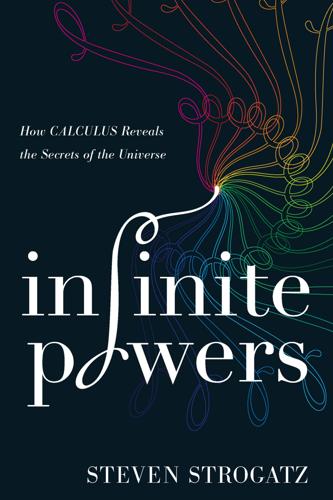
Infinite Powers: How Calculus Reveals the Secrets of the Universe
by
Steven Strogatz
Published 31 Mar 2019
To clarify what I mean by this somewhat apocalyptic warning, we need to understand how prediction is possible at all, what it meant classically, and how our classical notions are being revised by discoveries made in the past several decades in studies of nonlinearity, chaos, and complex systems. Early in the 1800s, the French mathematician and astronomer Pierre Simon Laplace took the determinism of Newton’s clockwork universe to its logical extreme. He imagined a godlike intellect (now known as Laplace’s demon) that could keep track of all the positions of all the atoms in the universe as well as all the forces acting on them. “If this intellect were also vast enough to submit these data to analysis,” he wrote, “nothing would be uncertain and the future just like the past would be present before its eyes.”
…
It wasn’t a matter of insufficient cleverness; she proved that there simply couldn’t be any formulas of a certain type (in the jargon, a meromorphic function of time) that could describe the motion of the top forever. In this way, she put limits on what calculus could do. If even a spinning top could defy Laplace’s demon, there was no hope—even in principle—of finding a formula for the fate of the universe. Nonlinearity The unsolvability that Sofia Kovalevskaya discovered is related to a structural aspect of the equations for a top: the equations are nonlinear. The technical meaning of nonlinear need not concern us here.
…
See technology inverse-square law of gravity, 195, 232–33 irrational numbers, discovery of, 33, 312n33 isochronism, 72 J Jefferson, Thomas, xxi–xxii, 239–40, 326n239 Jobs, Steve, 51 Johnson, Katherine, xxii, 237–38 Josephson, Brian, 73–74 Jupiter, 65, 80, 84 Jyesthadeva, 193 K Kasparov, Garry, 291–92 Kepler, Johannes awe of, xix background, 78 Cosmic Mystery, 78–81, 79 first law of planetary motion, 81–82 functions of one variable, 124–25 vs Galileo, 85–86 geometry and, 59–60 Harmonies of the World, 84 legacy of, 86–88, 234 logarithms, use of, 133 packing spheres problem, 293–94 on planetary motion, 79 Pythagorean fever, xiv second law of planetary motion, 82–84 third law of planetary motion, 84–85, 232–33 volumes, 92–93 Khwarizmi, Muhammad Ibn Musa al-, 92 King Hiero’s crown, 86 Koestler, Arthur, 86 Komodo, 292 Kovalevskaya, Sofia, 277–79, 280, 290 L La Chambre, Marin Cureau de, 116 Lagrange, Joseph Louis, 260 Laplace, Pierre Simon, 277 Laplace’s demon, 277, 279 lasers, xxii law of inertia, 71 law of odd numbers, 66–69 law of the lever, 28, 46 laws of motion Aristotelian understanding of, 60–64 circular motion, sine waves and, 108–12 first law of planetary motion, 81–82 force, 230–31, 252, 258 planetary motion, 81–85 second law of planetary motion, 82–84 third law of planetary motion, 84–85, 232–33 Le Blanc, Antoine-August (as pseudonym), 261–62 Leibniz, Gottfried Wilhelm approach to fundamental theorem, 211–18, 213 as co-inventor of calculus, 201–2 death of, 167–68 differentials, use of, 208–9 fundamental theorem, with differentials, 209–11 infinitesimals, 202–5, 324n203 integral sign, 211 Newton correspondence, 197, 199, 200–201, 323n199 levers, 28, 44–46 light bending of, xix, 114–18, 195, 209 composition of white light, 195, 197, 259 as electromagnetic wave, xi–xiii quantum electrodynamics, 296–97 speed of, 23, 263, 328n262 limits concept of, 8–9 in decimals, 9–11 of determinism, 278–80 infinity and, 13–14 Paradox of the Arrow, 19–21 linear relationships, 95–96, 126, 146–49, 173 Littlewood, John, 284–85 Liu Hui, 91 local operations, 185–86 logarithms, 131–34, 192, 196, 221 longitude, 74–75 M Madhava of Sangamagrama, 193 magic numbers, 217–18 magnetrons, 263–64 Marconi, Guglielmo, xi Mars period of, 84 retrograde motion, 61–62, 61, 62 sector areas, 82–83 Tycho and Kepler on, 78, 80 Mathematical Principles of Natural Philosophy (Newton), 229, 234, 236, 240 mathematics analysis vs synthesis, 102–3 discovery of, 49 Galileo on, 60 See also algebra; calculus; geometry Maxwell, James Clerk, xi, xii–xiii, 77, 264 “Measurement of a Circle” (Archimedes), 7 medical field CT scanning, 265–69 DNA, 273–76 facial surgery, 53–56 hepatitis C, 225 HIV progress, 218–25 Hodgkin-Huxley equations, 289 PET scans, 298 Mercator, Nicholas, 196 Mercury, 79, 80 Mersenne, Marin, 100–101 Method, the (of Archimedes), 42–50, 93, 313n47 method of exhaustion, 32, 47, 93, 102 method of least squares, 111 method of power series, 188–93 microwave ovens, 262–64, 328n262 Middle Ages, 50, 62, 173, 174 military aircraft, 245–47 Archimedes and, 27–28 ballistic data, 285–87 GPS, 76–77 nonlinear dynamics and radar, 284–85 modes of vibration, 259–60 moon Aristotle on, 60–61 Galileo’s observations, 65 gravity and, 232–33 inverse-square law of gravity, 195 Newton on, 229, 232–34 of Saturn, 278 Tycho on, 80 motion, 123–39 Archimedes’s study of, 315n57 exponential functions, 127–28 exponential growth and decay, 137–39 functions, role of, 125–26 fundamental theorem, 169–72 logarithms, 131–34 at a molecular scale, 165–66 natural logarithm (e), 134–37 of planets, 78–81 power functions, 126–27 scientific notation, 128–31 struggle with, xx two-body problem, 234–37 xy plane and, 123–24 Munro, Alice, 278 music continuous vs discrete, 20–21 CT scanning, 268 harmony and, 48–49, 230 logarithmic perception of pitch, 134 Newton on, 192 Pythagoras on, xiii–xiv, 230 string theory, 252–56 vibration modes, 259–60 N Napier, John, 133 Napoleon, 260, 261 NASA’s two-body problem, 237–38 natural logarithm (e), 134–37 nature calculus as language of, vii–viii, xiii–xiv, xix–xx, 166 circles in, 2 Galileo on, 67, 69, 70 logic of, 229–34 nonlinearity, 279–80 optimization principle, 118, 120 predator-prey interactions, 159 quantum mechanics, 21 rates of change, 143, 258 negative powers, 130 Neptune, 237 nerve cell communication, 286–87, 289 Newton, Hannah, 187, 188 Newton, Isaac analysis vs synthesis, 102–3 area problem, 176–79 background, 186–88 constant acceleration, 172–75 correspondence, 320n169, 322n195, 323n199 De Analysi, 196, 199, 200 De Methodis, 196, 197, 201 death of, 167–68 on Descartes, 102 discoveries of, viii, 195–97, 199–201, 322n195 discrete vs continuous systems, 241 Einstein’s theory of relativity, 299 fundamental theorem, 169–72, 182–83 gravity, force and nature, 229–34 legacy and influence of, xxi–xxii, 238–40, 325n229, 326n239 as mash-up artist, 193–94 Mathematical Principles of Natural Philosophy, 229, 234, 236, 240 method of power series, 188–93, 321n188 notebook, 182 pendulums, 72 Principia, 229, 234, 236, 240 System of the World, The, 236–37 three-body problem, 229, 281, 288 two-body problem, 234–38 xy plane, 124 Newton Project, 192 Nobel Prize winners, 267, 269, 278, 287, 298, 300 nonlinear equations, 96–97, 149–54 nonlinearity, 279–80, 299–300 nuclear reactions, 138 O Obama, Barack, 238 Oldenburg, Henry, 199–200 On Analysis by Equations Unlimited in Their Number of Terms (Newton), 196, 199, 200 “On the Sphere and Cylinder” (Archimedes), 49 “On the Unreasonable Effectiveness of Mathematics in the Natural Sciences” (Wigner), xiii optics curved lenses, 87, 99 principle of least time, 114–18 reflecting telescopes, 195 optimization algorithm, 110–11 optimization problems, 103–7, 116–18 orbits area of, 82–83 gravity and, 232–33 period of, 84–85 shape of, 81–82 See also ellipses; moon; planetary motion ordinary differential equations, 242–44 Oresme, Nicole, 173 oscillations, 73–74, 158–59 overtones, 254–55 “paint-roller” proof, fundamental theorem, 175–79, 178 P parabolas, 35–39 equations for, 97, 150 projectiles and, 70 as slice of cone, 36 slope and, 207–9 thought experiment for, 150–53 parabolic segment, 36–39, 43–44 Paradox of the Arrow, 19–21 parallax, 63 partial differential equations, 242–48, 249–50 patterns, 111–12 pendulums, 71–77, 158, 282–84, 288 Perelson, Alan, 219–25, 242 period, 109–10 period, or orbit, 84–85 PET scans, 298 phase, 109–10 physics electricity and magnetism, xi gravitational waves, 300 heat flow, 249–52 laws of planetary motion, 81–85 NASA’s two-body problem, 237–38 Newton’s legacy, 229–34 pendulums, 71–77, 158, 282–84, 288 quantum mechanics, 21–25, 77, 295–97 See also Galilei, Galileo; Newton, Isaac pi Archimedes’s estimation of, 29–32, 52 Chinese contribution to, 91 historical view of as ratio, 33–35 infinite decimals, 24 power series method, 189 Picasso, 166 Pixar, 51, 52, 314n52 pizza proof, 4–8 Planck, Max, 23 Planck length, 23 planetary motion, 78–81 Einstein on, 248 elliptical orbits, 81–82 Kepler on, xix Newton on, 234–37 orbital period, 84–85 sector areas, 82–84 planets vs stars, 61 Plato, 17, 60, 91 Plutarch, on Archimedes, 27 Poincaré, Henri, 281, 282–84, 288–89 polygons, 11–12 positron, 297–98 power functions, 126–27, 182 power series, method of, 188–93 powers of ten, 128–31 predator-prey interactions, 158–59 predictability horizon, 281–82 predictions antimatter, 297–98 for calculus, 273 electromagnetic waves, 264 fundamental theorem, 183–84 Josephson effect, 73–74 of new planets, 237 of orbits, 235–37 of particles in a continuous media, 256 quantum electrodynamics, 296–97 relativity and, 300 Principia (Newton), 229, 234, 236, 240 principle of least action, 118 principle of least time, 113–18, 319n118 projectile motion, 69–70 proportions, as Greek way, 33–35, 48 protease inhibitors, 219, 220–22, 223 “proto-calculus,” 227 Ptolemaic system, 63 Ptolemy, 63, 91 Pythagoras, xiii–xiv, 86, 90, 230 Pythagorean dream, 78, 86, 230 Pythagorean theorem, 31–32, 90 Pythagorean theory of musical harmony, 48–49 Q quadratic equations, 96–97, 126 quadrature, 36, 168–69 Quadrature of the Parabola, The (Archimedes), 35–39, 41, 43 quantum electrodynamics (QED), 296–97 quantum mechanics, 21–25, 77, 295–97 quarter cycle, of sine waves, 109, 109, 154, 156, 157–59, 257–59 Quinto, Todd, 269 R radar, 263–64, 284–85 “radar ranges.”

Possible Minds: Twenty-Five Ways of Looking at AI
by
John Brockman
Published 19 Feb 2019
The problems are different, and the kinds of knowledge needed to solve them are different. But instead of acknowledging the centrality of knowledge to intelligence, the dystopian scenarios confuse an artificial general intelligence of the future with Laplace’s demon, the mythical being that knows the location and momentum of every particle in the universe and feeds them into equations for physical laws to calculate the state of everything at any time in the future. For many reasons, Laplace’s demon will never be implemented in silicon. A real-life intelligent system has to acquire information about the messy world of objects and people by engaging with it one domain at a time, the cycle being governed by the pace at which events unfold in the physical world.
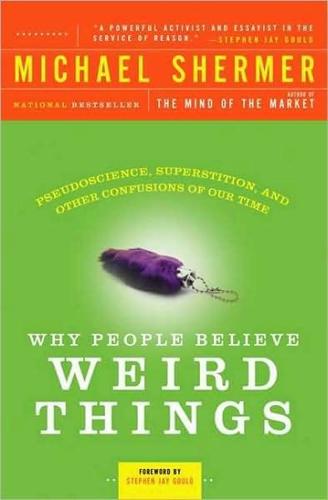
Why People Believe Weird Things: Pseudoscience, Superstition, and Other Confusions of Our Time
by
Michael Shermer
Published 1 Jan 1997
.: UMI Dissertation Information Service. ......... 1993. The Chaos of History: On a Chaotic Model That Represents the Role of Contingency and Necessity in Historical Sequences. Nonlinear Science Today 2, no. 4:1-13. ......... 1994. Satanic Panic over in UK. Skeptic 4, no. 2:21. ......... 1995. Exorcising Laplace's Demon: Chaos and Antichaos, History and Metahistory. History and Theory 34, no. 1:59-83. ......... 1999. How We Believe: The Searchfor God in an Age ofScience. New York: W. H. Freeman. ......... 2001. The Borderlands ofScience: Where Sense Meets Nonsense. New York: Oxford University Press. ......... 2002.

The Stuff of Thought: Language as a Window Into Human Nature
by
Steven Pinker
Published 10 Sep 2007
The theory in the history of physics that is closest to intuitive force dynamics is the medieval notion of impetus, in which a moving object has been imbued with some kind of vim or zest that pushes it along for a while and gradually dissipates. So there is a big discrepancy between intuitive physics, with its discrete episodes of causing and helping and overcoming a tendency toward rest, and real physics, which is just a bunch of differential equations specifying how objects change their velocity and direction over time. Laplace’s Demon, the hypothetical imp that knows the instantaneous positions and velocities of every particle in the universe, was said to be able to calculate the entire future or past by plugging these values into the equations that express the laws of mechanics and electromagnetism. The concept of a “cause,” or even a discrete “event,” plays no role.
…
Keysar, Boaz Khrushchev, Nikita kill killing Kim Jong Il, kinship metaphors Kipling, Rudyard Kitcher, Patricia Klein, Devrah knowing: a priori and a posteriori as having mutual knowledge Korean language Korff, Baruch Krebs, John Kripke, Saul Lakoff, George Lambek, Jim Langan, Michael language: combinatorial power of components of concreteness of as digital medium expanding perfect for reasoning as window into human nature see also language learning; semantics; syntax language acquisition, see language learning Language Instinct, The (Pinker) language learnability language learning as induction problem Linguistic Determinism and language of thought languages, see American Sign Language, Arabic language, Aymara language, Berber language, Chichewa language, Chinese language, Czech language, Danish language, Djirbal language, Dutch language, English language, French language, German language, Greek language, Hebrew language, Hungarian language, Igbo language, Indonesian language, Inuit languages, Italian language, Japanese language, Korean language, Papuan language, Portuguese language, Québecois French language, Russian language, Shona language, Spanish language, Tamil language, Tlingit language, Turkish language, Tzeltal language, Tzotzil language, Yiddish language, Yupik language Laplace’s Demon Larkin, Philip law Law & Order Lederer, Richard Lee, Peggy legalese Lehrer, Tom Leibniz, Gottfried Wilhelm Levin, Beth Levinson, Stephen Leviticus Lewis, C,S, Lewis, David Lexicon Branding Li, Peggy Lieberson, Stanley liff, meaning of Lillie, Beatrice limbic system Linguistic Determinism (Whorfian hypothesis) arguments against banal versions of and count-mass distinction defined on Eskimo words for snow interesting versions of radical versions of requirements for demonstrating linguistic relativity, see Linguistic Determinism (Whorfian hypothesis) literally literary metaphors conceptual metaphors contrasted with Lloyd, John locative construction gestalt-shift theory of idiosyncratic uses of learnability paradox universals and variation locative rule Locke, John logic “Logic and Conversation” (Grice) “love is a journey” metaphor “Love Me Two Times” (Doors) McCartney, Paul McCawley, James D.

On the Edge: The Art of Risking Everything
by
Nate Silver
Published 12 Aug 2024
There’s an uncanny amount of crossover among different communities within the River. *5 Recent developments in quantum mechanics have moved the needle toward the idea that the universe contains some intrinsic degree of randomness, but there are many interpretations of these phenomena and there is no clear scientific consensus. There is a long treatment of Laplace’s demon—the conjecture that if we knew the location and momentum of every particle in the universe, we could perfectly predict the future—in The Signal and the Noise. *6 “I don’t like the word ‘contrarian’—you just put a minus sign in front of some sort of wisdom-of-the-crowds-type thinking,” Thiel told me.
…
See poker, Garrett-Robbi hand Hyper-Commodified Casino Capitalism, 452–53, 487 I impartiality, 358–59, 360–61, 366–67, 368, 377, 487, 533n, 538n independence, 25, 31, 239–40, 249, 268, 273, 358 See also contrarianism index funds, 487 indifferent (game theory), 487 inductive reasoning, 487 Industrial Revolution, 461–62, 462, 487 infinite ethics, 360, 364–65, 487 inflection points, 487 innovator’s dilemma, 273–74n, 487 inside information finance and, 197n sports betting and, 177, 187n, 194, 197n, 212–13 instrumental convergence (AI), 418, 487 instrumental rationality, 372, 495 interpretability (AI), 433–34, 437, 479, 487 intrinsic value, 60, 482 Iowa Gambling Task, 93–94 IRR (internal rate of return), 487 Isaacson, Walter, 251 isothymia, 468, 471, 488 iteration, 61, 488 Ivey, Phil, 81, 98, 117, 129, 160 J Jackson, Gloria, 121 Jackson, Michael, 150 Jacob, Alex, 68 J-curve (venture capital), 260, 260, 488 Jezos, Beff, 410, 411 Jobs, Steve, 252, 265, 294, 406 Jordan, Michael, 94 Juanda, John, 87, 88 K Kahneman, Daniel, 105, 233, 427–28, 429, 430–31, 494, 498 Kant, Immanuel, 54, 367–68 Kaplan, Lewis, 382–83 Karikó, Katalin, 219, 223–24, 228–29, 239–40, 243n, 520n Kashiwagi, Akio, 151 Kasparov, Garry, 60 Kelly criterion, 396–400, 399, 408–9, 488, 538n Kennedy, John F., 424 Kenney, Ebony, 121–22 Kent, Michael, 195 Kerkorian, Kirk, 138, 144 Keynesian beauty contest, 285–86, 288, 290, 488 Khan, Lina, 269, 270, 272 Khosla, Vinod, 228, 249, 251, 269–70, 410 Kinney, David, 367 Kleiner, Eugene, 257, 296 Kline, Jacob, 241 Konnikova, Maria, 87, 88, 119, 123–24, 309, 313, 314 Koon, Jason, 113, 234, 243 Koppelman, Brian, 112 Kornegay, Jay, 174, 175, 176, 181–82, 202n Kühn, Ulrich, 425 Kurganov, Igor, 344, 347, 367 Kurzweil, Ray, 449–50, 497 Kyrollos, Gadoon “Spanky,” 191 arbitrage and, 172–73, 206 on bookmaking, 189–90 on bottom-up vs. top-down betting, 170–71 inside information and, 213 legal charges against, 208 Billy Walters and, 195 on whales, 207 L Laplace’s demon, 253n Laplante, Ryan, 106 large language models bias and, 440n competence of, 47 defined, 488 optimism and, 407, 414 poker and, 430–33 poor interpretability of, 433–34, 437, 479 reinforcement learning and, 440–41, 442, 495 science fiction and, 454 technological Richter scale and, 450 vectors in, 435–36, 500 See also AI; transformers Leach, Jim, 13 Lee, Timothy, 435n Le Guin, Ursula K., 454–55, 541n Leonard, Franklin, 289–90n LessWrong, 352, 355, 488 Levchin, Max, 251 leverage, 488 Levine, Matt, 310, 315, 337, 339, 374, 480, 489 Levitt, Steven, 90 Lew, Robbi Jade, 80–86, 89, 117, 123–29, 130, 444–45, 512n Li, Runbo, 318–19, 320 liberalism, 488 life expectancy, 10–11, 11, 30 Life You Can Save, The (Singer), 357, 533n Limit Hold’em, 488 limits (sports betting) algorithms for, 519n casino business and, 186–87 closing line value and, 206 defined, 172, 488, 516n extent of, 200, 210 lessons from sports betting and, 209, 520n line shopping and, 202, 203–4 market makers vs. retail bookmakers and, 187 prop bets and, 182 sports betting profitability and, 180 Lindley, Dennis, 482 line shopping (sports betting), 202–4, 488 liquidity, 488 Liveread (poker), 488 LLMs.

Giving the Devil His Due: Reflections of a Scientific Humanist
by
Michael Shermer
Published 8 Apr 2020
“The False Allure of Group Selection.” Edge.org "http://bit.ly/2m7pU8t Chapter 22 How Lives Turn Out 1. Shermer, Michael. 1993. “The Chaos of History: On a Chaotic Model that Represents the Role of Contingency and Necessity in Historical Sequences.” Nonlinear Science, 2:4., 1–13; Shermer, Michael. 1995. “Exorcising Laplace’s Demon: Chaos and Antichaos, History and Metahistory.” Invited paper for History and Theory. Wesleyan University. 34:1, 59–83; Shermer, Michael. 1997. “The Crooked Timber of History: History is Complex and Often Chaotic. Can We Use This to Better Understand the Past?” Complexity, 2:6, 23–29. 2. The White House. 2012.

Superforecasting: The Art and Science of Prediction
by
Philip Tetlock
and
Dan Gardner
Published 14 Sep 2015
I just Googled tomorrow’s sunrise and sunset times for Kansas City, Missouri, and got them down to the minute. Those forecasts are reliable, whether they are for tomorrow, the day after, or fifty years from now. The same is true of tides, eclipses, and phases of the moon. All can be predicted from clocklike scientific laws with enough precision to satisfy Laplace’s forecasting demon. Of course each of these pockets of predictability can be abruptly punctured. A good restaurant is very likely to open its doors when it says it will, but it may not, for any number of reasons, from a manager sleeping late, to fire, bankruptcy, pandemic, nuclear war, or a physics experiment accidentally creating a black hole that sucks up the solar system.

Blueprint: The Evolutionary Origins of a Good Society
by
Nicholas A. Christakis
Published 26 Mar 2019
From an early age, we categorize objects according to fundamental commonalities, discriminate between these categories, and assign each category a basic essence. P. Bloom, How Pleasure Works: The New Science of Why We Like What We Like (New York: W. W. Norton, 2010); S. A. Gelman, The Essential Child: Origins of Essentialism in Everyday Thought (New York: Oxford University Press, 2010). 40. In the end, we would get Laplace’s Demon. For “such an intellect,” French mathematician Pierre-Simon Laplace argued in 1814, “nothing would be uncertain and the future just like the past would be present before its eyes.” P. S. Laplace, A Philosophical Essay on Probabilities, 6th ed., trans. F. W. Truscott and F. L. Emory (New York: Dover, 1951), p. 4. 41.

Enlightenment Now: The Case for Reason, Science, Humanism, and Progress
by
Steven Pinker
Published 13 Feb 2018
Computers may be programmed to take on some of these problems (like recognizing faces), not to bother with others (like charming mates), and to take on still other problems that humans can’t solve (like simulating the climate or sorting millions of accounting records). The problems are different, and the kinds of knowledge needed to solve them are different. Unlike Laplace’s demon, the mythical being that knows the location and momentum of every particle in the universe and feeds them into equations for physical laws to calculate the state of everything at any time in the future, a real-life knower has to acquire information about the messy world of objects and people by engaging with it one domain at a time.

Engineering Security
by
Peter Gutmann
(This isn’t a new idea, going back at least as far as 17 th-century geeks like Gottfried Leibniz, who hoped that “it is always possible to terminate that part of a controversy that can be determined from the data […] so that it will suffice for two debaters to say to each other: let us calculate” [233]. This concept was later taken up by PierreSimon Laplace, who hoped that everything could be determined from Newtonian mechanics [234], an idea that became known as Laplace’s demon). The same thing happens outside the courtroom. The user doesn’t click through to the display of an X.509 certificate and say “The X.500 Distinguished Name of the certificate owner matches the name of the organisation with which I want to communicate and the certificate issuer is [and so on in this vein for another three pages] and therefore I can hand over my credit card details”.